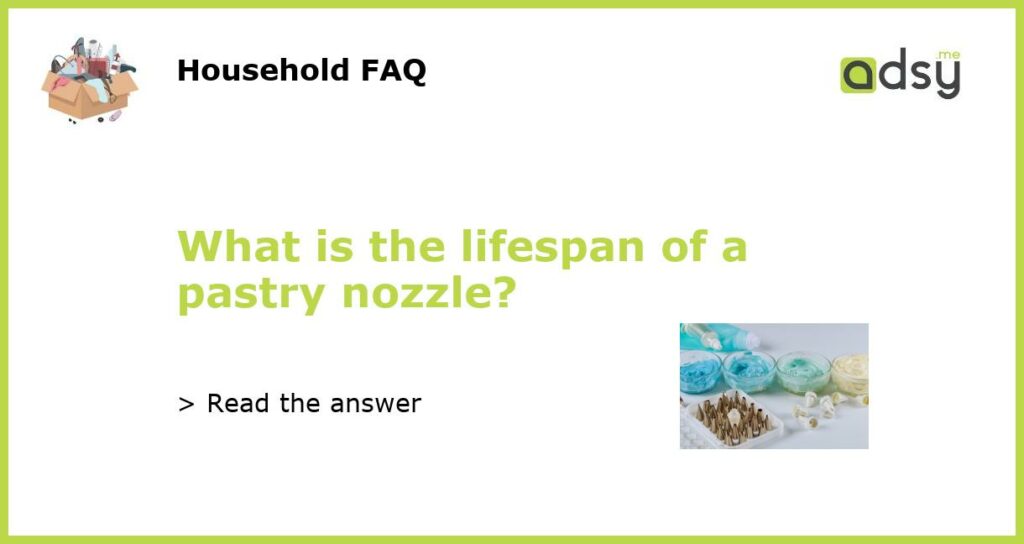Introduction
A pastry nozzle is a tool used in baking and pastry-making to shape and decorate various types of pastries, cakes, and desserts. It is commonly made from metal or plastic and comes in a variety of shapes and sizes. Pastry nozzles are a staple for professional bakers and home cooks alike, but how long do they typically last?
Lifespan of a Metal Pastry Nozzle
Metal pastry nozzles are generally more durable and long-lasting compared to their plastic counterparts. They are typically made from stainless steel, which is known for its strength and resistance to corrosion. With proper care and maintenance, a metal pastry nozzle can last for several years, or even decades.
To extend the lifespan of a metal pastry nozzle, it is important to clean and dry it thoroughly after each use. This helps prevent any residual batter or frosting from hardening and clogging the nozzle. Additionally, storing the nozzle in a dry and clean environment can help prevent rust or corrosion.
If a metal pastry nozzle starts to show signs of wear and tear, such as a damaged tip or rust, it may be time to replace it. However, with regular maintenance, a metal pastry nozzle can withstand heavy use and continue to produce beautiful and precise designs.
Lifespan of a Plastic Pastry Nozzle
Plastic pastry nozzles are typically more affordable and versatile compared to metal ones. However, they have a shorter lifespan due to their material composition. Plastic nozzles are more prone to cracking, breaking, and discoloration over time.
The lifespan of a plastic pastry nozzle can vary depending on the quality of the material and how it is used and cared for. With gentle use and regular cleaning, a plastic nozzle can last for several months to a few years. However, if a plastic nozzle becomes cracked or shows signs of deterioration, it is recommended to replace it to avoid any potential contamination or damage to the baked goods.
It is important to note that some plastic nozzles are not designed to withstand high temperatures, such as those required for piping hot fillings or working with melted chocolate. Using a plastic nozzle in high-temperature applications can cause the material to melt or warp, reducing its lifespan.
Factors Affecting the Lifespan
Several factors can affect the lifespan of a pastry nozzle, regardless of its material:
- Frequency of use: Nozzles that are used more frequently may wear out faster compared to those used occasionally.
- Type of batter/frosting: Some batters and frostings can be more abrasive or acidic, which can potentially damage the nozzle over time.
- Cleaning and maintenance: Regular and proper cleaning and maintenance can significantly extend the lifespan of a pastry nozzle.
- Storage conditions: Storing the nozzle in a clean and dry environment can help prevent damage and corrosion.
Considering these factors and taking appropriate precautions can help maximize the lifespan of a pastry nozzle, regardless of its material.
When to Replace a Pastry Nozzle
Knowing when to replace a pastry nozzle is essential for ensuring the quality and safety of your baked goods. Signs that indicate it may be time to replace a pastry nozzle include:
- Damaged or clogged tip: If the nozzle tip is damaged, bent, or clogged and cannot produce the desired shapes and designs, it may be time for a replacement.
- Cracks or breaks: For plastic nozzles, cracks or breaks in the material can lead to leakage or contamination of your batter/frosting.
- Rust or corrosion: In the case of metal nozzles, the presence of rust or corrosion can affect the quality and safety of your baked goods.
- Discoloration or odor: If the nozzle shows significant discoloration or emits an unpleasant odor, it may indicate contamination or degradation of the material.
It is important to prioritize the cleanliness and integrity of your pastry nozzle to ensure that you produce consistent and safe baked goods. With proper care and regular inspection, you can determine when it’s time to replace your pastry nozzle and continue creating beautiful and delicious treats.






